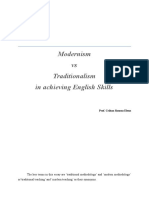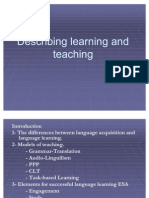Direct Method
Direct Method
Uploaded by
Aio AlzaidanyCopyright:
Available Formats
Direct Method
Direct Method
Uploaded by
Aio AlzaidanyCopyright
Available Formats
Share this document
Did you find this document useful?
Is this content inappropriate?
Copyright:
Available Formats
Direct Method
Direct Method
Uploaded by
Aio AlzaidanyCopyright:
Available Formats
Direct method in teaching a language is directly establishing an immediate and audio visual
association between experience and expression, words and phrases, idioms and meanings, rules
and performances through the teachers' body and mental skills, without any help of the learners'
mother tongue.
Direct method of teaching languages aims to build a direct way into the world of the target
language making a relation between experience and language, word and idea, thought and
expression rule and performance .This method intends for students to learn how to communicate
in the target language.
This method is based on the assumption that the learner should experience the new language in
the same way as he/she experienced his/her mother tongue without considering the existence of
his/her mother tongue.
The direct method is also known as natural method. It was developed as a reaction to the
grammar translation method and is designed to take the learner into the domain of the target
language in the most natural manner.
The main objective is to impart a perfect command of a foreign language. The main focus being
to make the learner think in the targeted language in the same manner as the learning of his/her
mother-tongue in the most natural way. In traditional language-learning, pupil participation was
found to be diminished as the teaching is perceived to be long and monotonous.
Communicative approach :
communicative approach, is an approach to language teaching that emphasizes interaction as
both the means and the ultimate goal of study. Learners in environments using CLT techniques
learn and practice the target language by interactions with one another and the instructor, the
study of "authentic texts" (those written in the target language for purposes other than language
learning), and the use of the language both in class and outside of class.
Learners converse about personal experiences with partners, and instructors teach topics outside
of the realm of traditional grammar to promote language skills in all types of situations. That
method also claims to encourage learners to incorporate their personal experiences into their
language learning environment and to focus on the learning experience, in addition to the
learning of the target language.
According to CLT, the goal of language education is the ability to communicate in the target
language. This is in contrast to previous views in which grammatical competence was commonly
given top priority. CLT also focuses on the teacher being a facilitator, rather than an instructor.
Furthermore, the approach is a non-methodical system that does not use a textbook series to
teach the target language but works on developing sound oral and verbal skills prior to reading
and writing.
You might also like
- Brand Naming: The Complete Guide To Creating A Name For Your Company, Product, or ServiceDocument45 pagesBrand Naming: The Complete Guide To Creating A Name For Your Company, Product, or ServiceCharlene KronstedtNo ratings yet
- Methods and Strategies in Teaching EnglishDocument27 pagesMethods and Strategies in Teaching EnglishSheena Namae Dacullo100% (2)
- Techniques and Principles in Language TeachingDocument229 pagesTechniques and Principles in Language TeachingWdy NingNo ratings yet
- Techniques and Principles in Language TeachingDocument229 pagesTechniques and Principles in Language TeachingNorman WattiNo ratings yet
- Techniques and Principles in Language TeachingDocument229 pagesTechniques and Principles in Language TeachingChrist Daniel Banda BandaNo ratings yet
- The Direct Method: It Is Also Called Natural Method Because It Is Learnt Naturally LikeDocument3 pagesThe Direct Method: It Is Also Called Natural Method Because It Is Learnt Naturally LikeSa MiraNo ratings yet
- Eight Approaches To Language TeachingDocument8 pagesEight Approaches To Language TeachingMihaela Toma100% (2)
- ModernismDocument7 pagesModernismSimona SymonyciNo ratings yet
- Act Part CDocument6 pagesAct Part CjersicaNo ratings yet
- Summary of Book Techniques and PrincipleDocument12 pagesSummary of Book Techniques and PrincipleM. KarimiNo ratings yet
- Techniques - and - Principle in TeachingDocument10 pagesTechniques - and - Principle in TeachingidoykcNo ratings yet
- Defferent ApproachesDocument8 pagesDefferent ApproachesElenaNo ratings yet
- 3.8 Approaches To Language TeachingDocument9 pages3.8 Approaches To Language Teachinghamid20pcNo ratings yet
- Module 3. A Brief History of Language Teaching 2Document10 pagesModule 3. A Brief History of Language Teaching 2Memy Muresan100% (1)
- Teaching Method - Direct Method 2Document5 pagesTeaching Method - Direct Method 2djoiajgNo ratings yet
- Language Teaching MethodDocument65 pagesLanguage Teaching MethodmontebonshieloNo ratings yet
- Final Assignment AlDocument9 pagesFinal Assignment AlHiền Anh NguyễnNo ratings yet
- Techniques and Principles in Language TeachingDocument301 pagesTechniques and Principles in Language TeachingSafriniNo ratings yet
- Lesson 8 Modern Language Teaching Methodlogies 1Document4 pagesLesson 8 Modern Language Teaching Methodlogies 1ramiishuuNo ratings yet
- Group #3 Methods Report.Document10 pagesGroup #3 Methods Report.maria gutierrezNo ratings yet
- Occasional Paper #1: Language Teaching Approaches I. SynopsisDocument5 pagesOccasional Paper #1: Language Teaching Approaches I. SynopsiskarenNo ratings yet
- Goals in Teaching English LanguageDocument11 pagesGoals in Teaching English Languageecarish100% (1)
- Divergent Evaluation in ELT Methods and Approaches - DidacticDocument4 pagesDivergent Evaluation in ELT Methods and Approaches - DidacticDerlin Katerine GarciaNo ratings yet
- Outline The Communicative Approach To Second Language TeachingDocument8 pagesOutline The Communicative Approach To Second Language TeachingliadhanNo ratings yet
- Eclectic TheoryDocument17 pagesEclectic TheoryNelson JayNo ratings yet
- Teaching MethodsDocument9 pagesTeaching Methodsrealtvy6113No ratings yet
- ELT Assignment 4th SemesterDocument7 pagesELT Assignment 4th SemesterAio AlzaidanyNo ratings yet
- Teacher Centered VS Students CenteredDocument10 pagesTeacher Centered VS Students CenteredRaniena Chokyuhyun100% (1)
- THE GRAMMAR TRANSLATION METHOD Focuses On Developing Students'Document6 pagesTHE GRAMMAR TRANSLATION METHOD Focuses On Developing Students'Turcan PaulaNo ratings yet
- Mga STRATEHIYA Sa Pagtuturo NG FilipinoDocument2 pagesMga STRATEHIYA Sa Pagtuturo NG Filipinoapril rose quibuyen100% (6)
- Whole Language ApproachDocument5 pagesWhole Language ApproachNawal DahmaniNo ratings yet
- Goals and Techniques For Teaching ListeningDocument23 pagesGoals and Techniques For Teaching ListeningArmen Neziri100% (1)
- Content-Based, Task-Based, and Participatory ApproachesDocument5 pagesContent-Based, Task-Based, and Participatory ApproachesDemet YEŞİLDAĞ83% (6)
- Communicative Language TeachingDocument16 pagesCommunicative Language Teachingadhie100% (1)
- Direct and Audio Lingual MethodsDocument15 pagesDirect and Audio Lingual MethodsDeshaniNo ratings yet
- Task Based Language TeachingDocument11 pagesTask Based Language TeachingNengah Arpurina ReskianNo ratings yet
- Ide - 209 - Linguistic - Bilici - Final EssayDocument5 pagesIde - 209 - Linguistic - Bilici - Final EssayHilal Vildan BiliciNo ratings yet
- Teaching Grammar For BeginnersDocument9 pagesTeaching Grammar For BeginnersHanzord NapoleonNo ratings yet
- English in An Engaging and Interactive Classroom: Review of Methods and MethodologyDocument15 pagesEnglish in An Engaging and Interactive Classroom: Review of Methods and Methodologykewin_walterNo ratings yet
- Communicative Language TeachingDocument29 pagesCommunicative Language TeachingMaria Fernanda NarvaezNo ratings yet
- Apuntes PPTDocument14 pagesApuntes PPTMariNo ratings yet
- Communicative MethodsDocument5 pagesCommunicative MethodsDunas SvetlanaNo ratings yet
- Describing Learning and TeachingDocument27 pagesDescribing Learning and TeachingEl Yazid KananeNo ratings yet
- Communicative CompetenceDocument15 pagesCommunicative CompetencePacurar EmmaNo ratings yet
- Methods and MethodologyDocument15 pagesMethods and MethodologyCarmen AlexeNo ratings yet
- 1 - Language Tea-WPS OfficeDocument11 pages1 - Language Tea-WPS OfficeCELESTINNo ratings yet
- HMLB021Document3 pagesHMLB021mashabalerato26No ratings yet
- 14.INNOVATIVE TECHNIQUES AND CURRENT METHODS IN TEACHING AND LEARNING ENGLISH LANGUAGE FOR - No PropDocument10 pages14.INNOVATIVE TECHNIQUES AND CURRENT METHODS IN TEACHING AND LEARNING ENGLISH LANGUAGE FOR - No Propbaenglishliterature 2No ratings yet
- 1-8 билеты дидактикаDocument8 pages1-8 билеты дидактикаIura ScerbaniucNo ratings yet
- Module in Approaches For Language Arts TeachingDocument6 pagesModule in Approaches For Language Arts TeachingrosevicabangayNo ratings yet
- Methods of Teaching English As A Foreign Language Task 2Document7 pagesMethods of Teaching English As A Foreign Language Task 2IVONNE GARCIANo ratings yet
- Language SkillsDocument7 pagesLanguage SkillsAlgen Jewel BalbinNo ratings yet
- Approaches and Methods in EFLDocument45 pagesApproaches and Methods in EFLemo_transNo ratings yet
- Approaches in Language Teaching PPT Mary Rose A. RamirezDocument12 pagesApproaches in Language Teaching PPT Mary Rose A. RamirezJoshua Dome G. Bustamante100% (1)
- What Is Silent Way MethodDocument2 pagesWhat Is Silent Way MethodRawezh NorieyNo ratings yet
- Delta Teaching ApproachesDocument1 pageDelta Teaching Approachesasdfasdfasdfadsf1No ratings yet
- Language Learning Materials DevelopmentDocument8 pagesLanguage Learning Materials DevelopmentKazandra Nichole JoaquinNo ratings yet
- Direct MethodDocument9 pagesDirect MethodIoannes Amare Et ServireNo ratings yet
- Btech 1 Sem Programming For Problem Solving kcs101 2022Document2 pagesBtech 1 Sem Programming For Problem Solving kcs101 2022rishabhchauhan2266No ratings yet
- Learnenglish Howto Understand The Difference Between The Uk and Great BritainDocument3 pagesLearnenglish Howto Understand The Difference Between The Uk and Great Britainapi-427719699No ratings yet
- Worksheet 2.11 Unit TestingDocument7 pagesWorksheet 2.11 Unit TestingGloria Forero NemeNo ratings yet
- Đề HSG TA 2023-2024 bang BDocument13 pagesĐề HSG TA 2023-2024 bang BNguyễn Thanh MỹNo ratings yet
- Walsh HadamardDocument3 pagesWalsh Hadamardharshalpareta148No ratings yet
- 21ST Century Lit GenresDocument34 pages21ST Century Lit GenresKatrin Lutao75% (4)
- Process Oriented Performance Based AssessmentDocument29 pagesProcess Oriented Performance Based AssessmentKristel Uy0% (1)
- Spring 2023 Popular Culture Project Assignment Sheet & RubricDocument4 pagesSpring 2023 Popular Culture Project Assignment Sheet & RubricAshley BeardsleyNo ratings yet
- Chahaar Anwa Huzoor Syed Shah Barkatullah MarehraviDocument80 pagesChahaar Anwa Huzoor Syed Shah Barkatullah MarehraviDr. Mushahid Razvi100% (2)
- Medieval Monsters Web GuideDocument9 pagesMedieval Monsters Web GuideEm100% (1)
- Vocabulary Fitness ManualDocument6 pagesVocabulary Fitness ManualAhmed ElgebalyNo ratings yet
- MIMAMSA PHILOSOPHY ThursdayDocument4 pagesMIMAMSA PHILOSOPHY ThursdayGaluh SadewaNo ratings yet
- Irregular Verbs, Past Tense and Past ParticipleDocument6 pagesIrregular Verbs, Past Tense and Past ParticipleSubathara Pindaya100% (2)
- 1 CorinthiansDocument49 pages1 Corinthiansapi-460759192No ratings yet
- Computer-Studies-Grade 8Document30 pagesComputer-Studies-Grade 8Chaiwa JustineNo ratings yet
- List of Literary MovementsDocument8 pagesList of Literary MovementsKai KokoroNo ratings yet
- ENG-111-LEC-1812S Week 20 - Second Quarter ExamDocument22 pagesENG-111-LEC-1812S Week 20 - Second Quarter ExamSofia Angela NacarioNo ratings yet
- Graduation SongsDocument1 pageGraduation SongsDimple LptNo ratings yet
- Should - Shouldn't - Grupo 2Document14 pagesShould - Shouldn't - Grupo 2jade campos avelinoNo ratings yet
- C++ Assignment 2Document11 pagesC++ Assignment 2samuel mitikuNo ratings yet
- Google Soa ReportDocument14 pagesGoogle Soa ReportFknr FekanereNo ratings yet
- AmizoneDocument2 pagesAmizonemanprit.7020No ratings yet
- SampleDocument4 pagesSampleinduNo ratings yet
- New Yorker in Tondo: PrologueDocument30 pagesNew Yorker in Tondo: PrologueSrJocelyn L. BetacheNo ratings yet
- Unit-04 Java MCQ - 16944662 - 2023 - 03 - 24 - 19 - 51Document8 pagesUnit-04 Java MCQ - 16944662 - 2023 - 03 - 24 - 19 - 51Ujjwal DubeyNo ratings yet
- Manual Plant Simulation Parte 2Document30 pagesManual Plant Simulation Parte 2jaciel barajasNo ratings yet
- Video File Format Spec v10Document48 pagesVideo File Format Spec v10droger100% (4)
- C# Web API Cheat SheetDocument1 pageC# Web API Cheat SheetRic Darryl Villaruz0% (2)
- Freshman English LP 2Document2 pagesFreshman English LP 2api-334927945No ratings yet

























































































